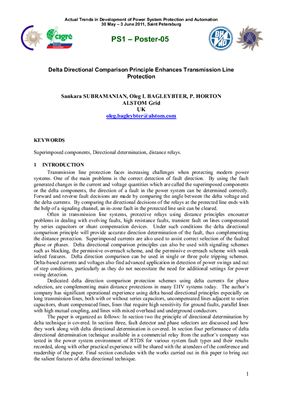ALSTOM Grid
UK
Transmission line protection faces increasing challenges when protecting mode power systems. One of the main problems is the correct detection of fault direction. By using the fault generated changes in the current and voltage quantities which are called the superimposed components or the delta components, the direction of a fault in the power system can be determined correctly. Forward and reverse fault decisions are made by comparing the angle between the delta voltage and the delta currents. By comparing the directional decisions of the relays at the protected line ends with the help of a signaling channel, an in-zone fault in the protected line unit can be cleared. Often in transmission line systems, protective relays using distance principles encounter problems in dealing with evolving faults, high resistance faults, transient fault on lines compensated by series capacitors or shunt compensation devices. Under such conditions the delta directional comparison principle will provide accurate direction determination of the fault, thus complementing the distance protection. Superimposed currents are also used to assist correct selection of the faulted phase or phases. Delta directional comparison principles can also be used with signaling schemes such as blocking, the permissive overreach scheme, and the permissive overreach scheme with weak infeed features. Delta direction comparison can be used in single or three pole tripping schemes. Delta-based currents and voltages also find advanced application in detection of power swings and out of step conditions, particularly as they do not necessitate the need for additional settings for power swing detection.
UK
Transmission line protection faces increasing challenges when protecting mode power systems. One of the main problems is the correct detection of fault direction. By using the fault generated changes in the current and voltage quantities which are called the superimposed components or the delta components, the direction of a fault in the power system can be determined correctly. Forward and reverse fault decisions are made by comparing the angle between the delta voltage and the delta currents. By comparing the directional decisions of the relays at the protected line ends with the help of a signaling channel, an in-zone fault in the protected line unit can be cleared. Often in transmission line systems, protective relays using distance principles encounter problems in dealing with evolving faults, high resistance faults, transient fault on lines compensated by series capacitors or shunt compensation devices. Under such conditions the delta directional comparison principle will provide accurate direction determination of the fault, thus complementing the distance protection. Superimposed currents are also used to assist correct selection of the faulted phase or phases. Delta directional comparison principles can also be used with signaling schemes such as blocking, the permissive overreach scheme, and the permissive overreach scheme with weak infeed features. Delta direction comparison can be used in single or three pole tripping schemes. Delta-based currents and voltages also find advanced application in detection of power swings and out of step conditions, particularly as they do not necessitate the need for additional settings for power swing detection.

